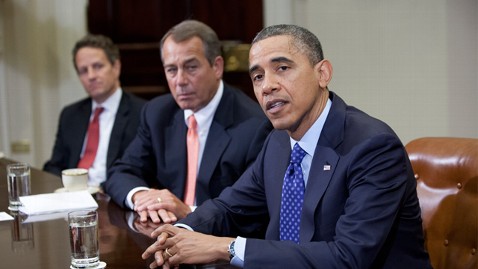
(J. Scott Applewhite — AP)
“Raising taxes on the so-called top two percent — half of those taxpayers are small business owners who pay their taxes through their personal income tax filing every year.”
— House Speaker John Boehner (R-Ohio), Nov. 28, 2012
The Speaker misspoke — again.
A reader asked us about this statement, and we noticed that it was similar to a claim he made last year. His spokesman at the time explained that Boehner had meant to say “half of small business income,” but he misspoke. We don’t try to play gotcha here, so we gave Boehner a pass.
But in the midst of the “fiscal cliff” debate, he said it again. Once again, his spokesman said it was a mistake. “He meant to say half of small business income would be hit by the President’s plan for higher tax rates,” said spokesman Brendan Buck.
We think it’s time for a refresher course, especially since we previously looked askance at the claim that the tax hike would hit half of all small-business income. Such assertions about small businesses keep coming up time and again in this debate, and it is a complex issue.
The Facts
Higher taxes on individuals would hit just over 50 percent of business income. But they aren’t necessarily “small” businesses.
There are advantages for companies to file corporate income taxes, but there is one big disadvantage — major shareholders are subject to being taxed twice, first on the corporation’s earnings and then on personal income taxes after dividends are distributed to the owners.
So smaller companies, as well as partnerships, sole proprietorships and some limited liability companies, organize themselves differently. The companies themselves do not pay taxes; instead, the earnings or losses are passed through to the shareholders, who then are taxed at the individual tax rate.
When Republicans often speak of “small businesses,” they are referring to the companies that file under the individual tax code. But not all of them are what most Americans would consider small businesses — and not all of them are that small, either. In fact, a report by the Joint Committee on Taxation — the nonpartisan congressional entity that assesses tax legislation — found that the number of tax returns by so-called “flow-through entities” has soared in recent years.
As of 2005, the JCT says, retail trade (such as mom-and-pop shops) accounted for about 11 percent of so-called S corporations, holding 12 percent of total assets, and 5 percent of partnerships, with less than 1 percent of total assets. Another 14 percent of S corporations were in construction but the largest category, at 15 percent, were “professional, scientific and technical services.”
The result, according to the Joint Committee on Taxation, is that only 3 percent of all “small businesses” paying taxes would be affected by Obama’s plan to lift marginal tax rates on families making more than $250,000 and individuals making more than $200,000. (See page 25 of the JCT report.)
That group — about 750,000 taxpayers — accounts for 50 percent of the estimated $1 trillion in business income reported in 2011, though it would seem the big money is being made by a relatively small group of companies, law firms and the like. The other 97 percent of “small businesses” shared the rest — and under Obama’s plan, they would get to keep their Bush-era tax cuts.
There is also another, possibly more precise way to measure impact of income of small businesses affected by a possible tax hike.
Career economists at the Treasury Department, in a study released last year by the Office of Tax Analysis, dug deep into 2007 tax data to determine the taxes paid by small businesses. The study proposed two definitions of a small business, including a “narrow definition”: people who get at least 25 percent of their adjusted gross income from small-business income.
To our mind, this metric would seem to get closer to the category of mom-and-pop shops, what people generally think of as small businesses. (The broader definition includes anyone who earned any small-business income, even as little as a $1 — which suggests the taxpayer really is not managing the business.)
Table 14 of the study shows that, under the narrow definition, taxpayers with adjusted gross income of above $200,000 — about 700,000 taxpayers — amount to about 7.5 percent of all small-business owners. (The percentage is only a little higher under the broader definition.) Still, that is more than double the 3-percent figure of the Joint Tax Commitee, which is often cited by Democrats.
Those small-business taxpayers earned about 57 percent of all small-business income, but much of it was concentrated in the $200,000 to $500,000 category. Small businesses making more than $1 million, for instance, amount to just 14 percent of small-business income.
The Pinocchio Test
By any measure, Boehner’s statement last week was incorrect. Only a relatively small percentage of small-business owners would be affected by a tax increase. His amended statement, focused on small-business income, is more accurate, according to the Treasury Department study and the Joint Committee on Taxation.
There is some question, however, whether even that claim is especially relevant. Readers with personal experience have fiercely disputed whether higher taxes would make much difference in whether a small business would hire new employees. “A higher personal income tax rate is an incentive to hiring more people and investing more in a business to make it grow, because you’re leveraging pre-tax money,” one reader argued.
In any case, a repeated mistake does not get a repeated pass, given that his words were widely reported
in the media as fact. There is a huge difference between reporting half of all small-business owners and half of all small-business income. Boehner needs to be much more careful in how he makes his case against higher tax rates.
Three Pinocchios

(About our rating scale)
Check out our candidate Pinocchio Tracker
Follow The Fact Checker on Twitter and friend us on Facebook
.

























